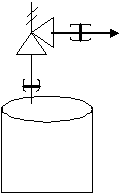Chemical and Process Engineering Resources

Rupture Disks for Process Engineers - Part 1
Nov 08 2010 01:30 PM | pleckner in Safety and Pressure ReliefCost Comparison Between Comparable Stand-Alone Rupture Disk and Relief Valve
Rupture disk manufacturers burst at least two disks per lot before shipping them to a customer.
Below is a capital cost comparison between Continental Disc Corp. (www.contdisc.com) 3" Ultrx Hastelloy C rupture disks with holders and Farris Engineering (www.cwfc.com) 2600 series relief valves, based on a budget estimate in year 2001 dollars.
Â
Basis: Continental Disc | Basis: Farris Engineering |
3" Ultrx Hast C Disc = $2,600 for 1st usable disk, then $870 each | 3" x 4" Hast C 26KA10-120 = $13,400 |
3" Ultrx Hast C Holder = $3,300 ea. | Â |
TOTAL for one pair = $5,900 | Â |
TOTAL for three pair = $14,240 | TOTAL for three = $40,200 |
This capital cost comparison will vary considerably with size and material of construction but you get the point. However please note that everything has a value and the loss of contents should be considered in the overall cost difference between a rupture disk and a relief valve.
When Do We Use a Rupture Disk-Relief Valve Combination?
Rupture disks are often used in combination with and installed just upstream and/or just downstream of a relief valve. You may want to choose the combination option if:
 |
| Figure 3: Rupture Disk- Relief Valve Combination |
Â
1. You need to ensure a positive seal of the system (the system contains a toxic substance and you are concerned that the relief valve may leak). Application: rupture disk installed upstream of the relief valve.
2. The system contains solids that may plug the relief valve over time. Remember, the relief valve is continuously exposed to the system. Application: rupture disk installed upstream of the relief valve.
3. TO SAVE MONEY! If the system is a corrosive environment, the rupture disk is specified with the more exotic and corrosion resistant material. It acts as the barrier between the corrosive system and the relief valve. Application: rupture disk installed either upstream and/or downstream of the relief valve.
Below is a capital cost comparison between combination Hastelloy C rupture disks with stainless steel relief valves and three stand-alone Hastelloy C relief valves. Again, this is based on a budget estimate in year 2001 dollars using Continental Disc Corp. rupture disks and holders and Farris Engineering relief valves.
Basis: Continental Disc | Basis: Farris Engineering |
3" Ultrx Hast C Holder = $3,300 | 3" x 4" Hast C 26KA10-120 = $13,400 |
3" Ultrx Hast C Disc = $2,600 for 1st usable disk, then $870 each | 3" x 4" SS 26KA10-120 = $4,300 |
Combination of Hastelloy C Disk and SS Relief Valve
Single Installation Total = $10,200
Total for three installations = $27,140
Three stand-alone Hastelloy C relief valves = $40,200
Summary
A stand-alone rupture disk is used when:
You are looking for capital and maintenance savings
You can afford to loose the system contents
The system contents are relatively benign
You need a pressure relief device that is fast acting
A relief valve is not suitable due to the nature of the system contents
A rupture disk / relief valve combination is used when:
- You need to ensure a positive seal of the system
- The system contains solids that may plug the relief valve over time
- TO SAVE MONEY! If the system is a corrosive environment, the rupture disk is specified with the more exotic and corrosion resistant material
References
- API (www.api.org) Recommended Practice 520, "Sizing, Selection, and Installation of Pressure-Relieving Device in Refineries, Part 1-Sizing and Selection", 7th Edition (January 2000)
- API (www.api.org) Recommended Practice 521, "Guide for Pressure-Relieving and Depressuring Systems", 4th Edition (March 1997)
- ASME (www.asme.org) "Boiler and Pressure Vessel Code, Section VIII, Division 1" (1998)

 FB
FB

1 Comments
At my place rupture disc usually used as second barrier of pressure safety device.
In other words, if the pressure keep rising and cause the pressure relief broken, the rupture disc break and release the content remaining in the system.